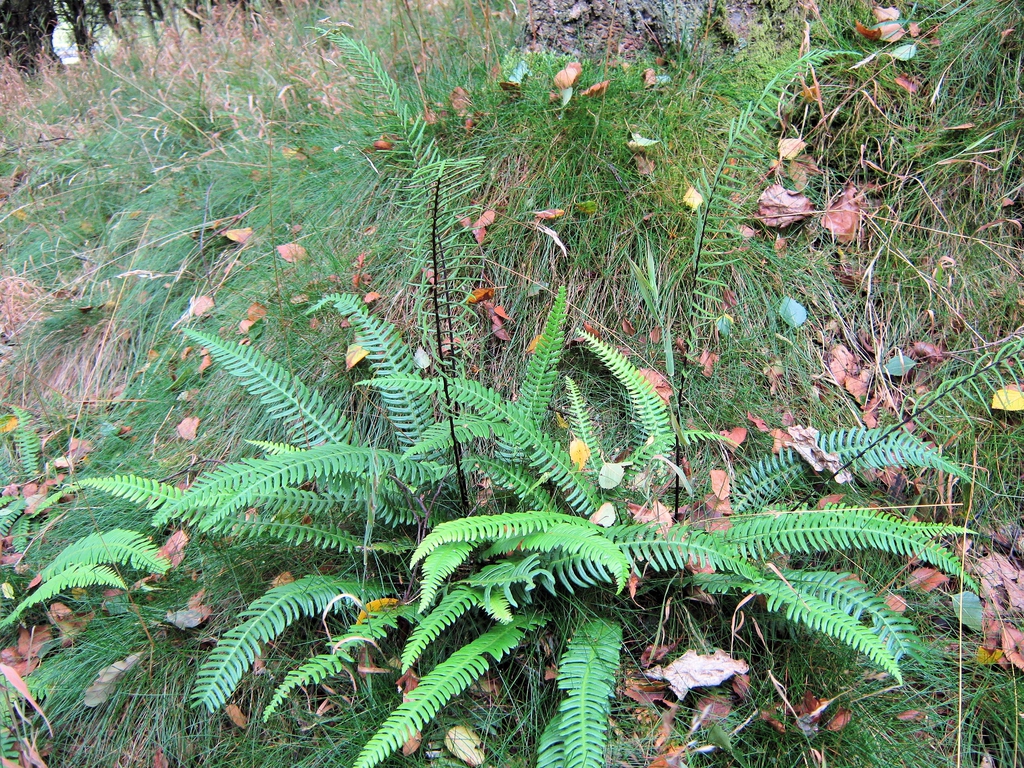Blechnum spicant
- Phonetic Spelling
- BLECK-num SPIK-ant
- Description
-
Deer Fern is an evergreen fern with ascending rhizomes that spread slowly, although it can also be propagated by division in the Spring. Deer Fern is native to Europe, spreading east as far as Japan, and Northwestern North America from Alaska, British Columbia, and south to Idaho, Oregon, and northern California. It is typically found growing along the coast in woods, heaths, moors, mountain grassland and on rocks. It is winter hardy and resistant to damage from deer and rabbits. This fern is unusual in that it produces two types of fronds; sterile evergreen fronds that are replaced late in the season by taller fertile fronds growing out of the center of the sterile fronds. The genus name, blechnum, comes from the classical Greek name for a fern.
Deer Fern prefers acidic, humus-rich moist soil with good drainage and is partial to full shade. It will tolerate poor soil and heavy clay as well as shady sites with adequate moisture. It would be useful as a ground cover in a shady site.
Diseases, Insect Pests, and Other Plant Problems:
No known diseases or insect pests. However, leaf spot and rust can sometimes occur.
VIDEO Created by NC State Extension's Homegrown series featuring Mark Weathington, Director of JC Raulston Arboretum.
- Profile Video:
- See this plant in the following landscape:
- Cultivars / Varieties:
-
- Tags:






























- Cultivars / Varieties:
-
- Tags:
-
-
Attributes:
- Genus:
- Blechnum
- Species:
- spicant
- Family:
- Aspleniaceae
- Life Cycle:
- Perennial
- Recommended Propagation Strategy:
- Division
- Country Or Region Of Origin:
- Northwest Africa, Europe to Iran, Japan.
- Distribution:
- Southern Alaska through Canada and western United States.
- Particularly Resistant To (Insects/Diseases/Other Problems):
- Heavy shade, Deer
- Dimensions:
- Height: 0 ft. 9 in. - 1 ft. 6 in.
- Width: 1 ft. 0 in. - 2 ft. 0 in.
-
-
Whole Plant Traits:
- Plant Type:
- Fern
- Woody Plant Leaf Characteristics:
- Broadleaf Evergreen
- Habit/Form:
- Ascending
- Erect
- Growth Rate:
- Slow
- Maintenance:
- Low
- Texture:
- Coarse
-
-
Cultural Conditions:
- Light:
- Deep shade (Less than 2 hours to no direct sunlight)
- Full sun (6 or more hours of direct sunlight a day)
- Partial Shade (Direct sunlight only part of the day, 2-6 hours)
- Soil Texture:
- Clay
- High Organic Matter
- Loam (Silt)
- Sand
- Soil pH:
- Acid (<6.0)
- Neutral (6.0-8.0)
- Soil Drainage:
- Good Drainage
- Moist
- USDA Plant Hardiness Zone:
- 4a, 4b, 5a, 5b, 6a, 6b, 7a, 7b, 8a, 8b
-
-
Fruit:
- Display/Harvest Time:
- Summer
- Fruit Description:
- No fruits. This plant reproduces by means of spores.
-
-
Flowers:
- Flower Description:
- No flowers; fertilized through spores.
-
-
Leaves:
- Woody Plant Leaf Characteristics:
- Broadleaf Evergreen
- Leaf Color:
- Green
- Leaf Feel:
- Leathery
- Leaf Value To Gardener:
- Showy
- Leaf Type:
- Compound (Pinnately , Bipinnately, Palmately)
- Fronds
- Leaf Shape:
- Lanceolate
- Hairs Present:
- No
- Leaf Length:
- > 6 inches
- Leaf Width:
- 1-3 inches
- Leaf Description:
- This plant has a green, lance-shaped rosette that is pinnatifid, feels stiff and leathery, and arises in a vase-shaped clump. These fronds can be as long as 24 inches or as short as 8 inches. The fronds initially form a loose, flat rosette that is sterile. Later, fertile fronds 16 to 24 inches high emerge vertically from the rosette. They are similar to the sterile ones but taller, with much thinner and widely separated leaflets. Fertile fronds turn brown and wither by the end of the summer, leaving the evergreen sterile rosette.
-
-
Stem:
- Stem Is Aromatic:
- No
- Stem Description:
- Stems slender, short-creeping or ascending, not climbing.
-
-
Landscape:
- Landscape Location:
- Woodland
- Landscape Theme:
- Rock Garden
- Shade Garden
- Design Feature:
- Border
- Mass Planting
- Resistance To Challenges:
- Deer
- Heavy Shade
- Rabbits







